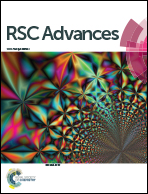A highly active bimetallic oxide catalyst supported on γ-Al2O3/TiO2 for catalytic wet peroxide oxidation of quinoline solutions under microwave irradiation†
Abstract
A new heterogeneous wet oxidation catalyst, Cu–Ni bimetallic oxides supported on γ-Al2O3/TiO2, was synthesized using a wet impregnation method. The physicochemical characteristics of the as-synthesized catalyst were assessed using various modern methods such as scanning electron microscopy with energy dispersive X-ray spectroscopy (SEM-EDX), X-ray diffraction (XRD), N2 adsorption–desorption, and X-ray photoelectron spectroscopy (XPS). Compared with monometallic Cu or Ni oxide catalysts, this new supported Cu–Ni bimetallic oxide catalyst presented a higher activity and stability in quinoline mineralization. The impact of the microwave (MW) power, temperature, pH and H2O2 dosage was studied on the basis of the TOC mineralization. At a MW power of 500 W, pH 7, 333 K and a 22.75 mmol L−1 H2O2 dosage, an 81% abatement of the TOC was reached. Based on the results of metal leaching and XPS analysis, the stability of the Cu–Ni bimetallic supported catalyst, along with the role of the copper and nickel, is discussed.


 Please wait while we load your content...
Please wait while we load your content...